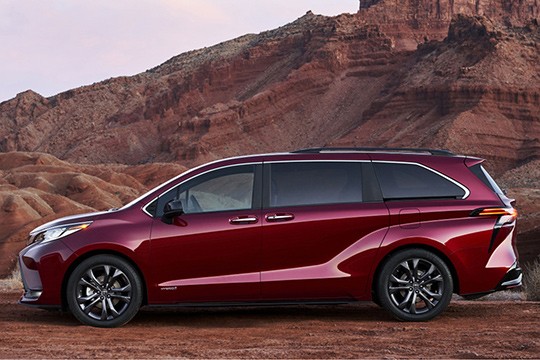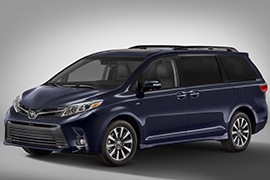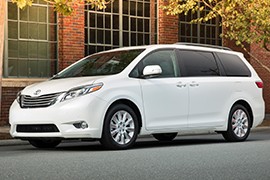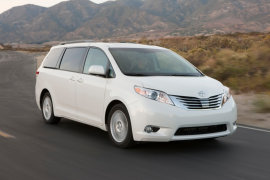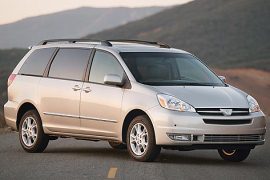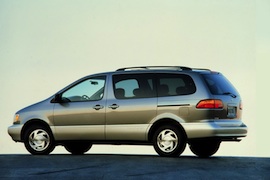TOYOTA Sienna Models/Series Timeline, Specifications & Photos
First production year: 1998
Engines: Hybrid, Gasoline
Body style: Van
Toyota made the Sienna as a family carrier, and, in 2020, it unveiled the fourth minivan built for the North-American market.
The Sienna was planned to be unveiled at the 2020 New York International Auto Show, but due to the world COVID-19 pandemic, the show was canceled. The Japanese car-maker didn't give up and unveiled it online in May 2020. The minivan was based on the Toyota TNGA-K platform (Toyota New Global Architecture-K) used for the Highlander range. But that didn't transform the MPV into an SUV.
The exterior design was not one of the best in class, nor best in Toyota's lineup. The front apron featured a grille so prominent that it almost covered it. There were only a few areas that were untouched by the horizontal slats. Above the bumper, the slim headlights, which might have fit better on a Camry, featured the daytime running lights. The greenhouse featured a slightly sloped roof and two thick, D-pillars in the back. The tailgate looked like the Corolla station-wagon inspired it. The sculptured door panels and rear fenders made the car a little bit more appealing on the sides.
The interior was the one that stood out with its three-row seating position. The ceiling was the mounting area for the rear infotainment system, so the back's kids won't get too bored before reaching the destination. The trunk was big, mostly if the third row was not in use.
The Sienna was fitted with only one powertrain: the hybrid system. It was powered by a 2.5-liter Atkinson engine and an electric motor. Both were mated to a CVT gearbox.
The U.S. MPV market was highly competitive and forced the carmakers to improve their vehicles more often than other cars, and Toyota needed to keep the pace.
Toyota introduced the third generation of the Sienna in 2010, and by 2017 it already improved it a few times. But that didn't stop the Japanese carmaker from bringing new changes, and some were significant.
On the outside, the 2017 Sienna featured a new front fascia with a broad, trapezoidal-shaped lower grille on the front bumper. It was flanked by two LED fog lights placed in individual clusters on the apron's outer sides. Apart from that, the carmaker considered including a laminated windshield and front side windows.
Toyota made an important step forward in the safety department introducing the TSS-P system, which included pedestrian detection, adaptive cruise control, auto-braking, or the lane-keep assist. For the interior, the Japanese carmaker upgraded the entire range to the Entune 3.0 multimedia system. It featured a live-traffic map for all the trim levels, while the upper ones received WiFi connectivity for up to five devices via 4G LTE. Toyota introduced a JBL sound system with a 10.1" subwoofer as an option for the SE and XLE trim levels and standard for the Limited.
Starting with the 2017 Sienna, Toyota dropped the six-speed automatic gearbox and replaced it with a newly developed eight-speed unit, which sent the power to the front axle or in all corners.
While the minivans market was not so big as before since the SUV and crossover one increased their importance, the Sienna took the challenge to fight for that niche market.
The 2014 Sienna minivan reached its third generation in 2010. It was upgraded in 2014 and was the only MPV with an available all-wheel-drive system. It was something that you couldn't get in a Honda Odyssey or Chrisler Town&Country from the same period.
From the outside, the Sienna tried hard not to look like a box on wheels. The designers imagined a short hood and placed a mesh-grille with motorsports theme inspiration. For easy access, Toyota installed two regular doors at the front and two power-sliding in the rear. At the back, a big power-tailgate offered easier access to the trunk. The big, horizontal taillights were shaped to cover a part of the D-pillars and a part of the tailgate.
Inside, like any other minivan in its class, the Sienna offered room for up to eight passengers. The middle row could have been changed for a pair of captain seats for those who want to provide more comfort for their families or friends. In the third folding and stow-away row, there was enough room for two adults. The instrument cluster was easy to read for the driver with a mix of analog dials and LCD panel.
The Sienna featured a 266 hp V6 under the hood, mated to a standard 6-speed automatic transmission. For the SE version, it was fitted with bigger wheels and a stiffer suspension.
Toyota introduced the third generation of the Sienna minivan at the 2009 Los Angeles Auto Show, and it boasted a new presence with improved safety and comfort features.
Along the road, Toyota managed to understand the minivan users' desires and put offered them into one package. The Sienna was hardly able to conquer any design contest, but it definitely won many hearts from customers, being not only a true seven-seater but also the only AWD MPV for many years on the U.S. market.
Designers had a tough time when they penned the Sienna due to the complex car's architecture and the amenities that had to be placed inside. Thus, the car needed a short overhang with a tall front fascia that had to resemble the same design language as the rest of the Toyota range. Its slatted grille and the swept-back headlights looked similar to those installed on the Avalon. The wide and tall windscreen followed a steeper angle than the short hood. On the sides, the dual power-sliding doors provided a wide opening for easy ingress and egress.
Inside, the carmaker created a dashboard design with two distinct areas for the driver and the side passenger. Thus, the driver could focus more on driving and less on adjusting the cabin temperature. Yet, the sound system featured the volume button on the left side.
The Sienna's platform was not entirely new, and Toyota carried over the older V6 engine from the previous generation. Since it was a very trustworthy unit, nobody was concerned about it. Moreover, until the end of the third generation in 2020, it was the only mass-market minivan available with an all-wheel drive system.
Toyota introduced the second generation of the Sienna minivan in late 2003 as a 2004 model year and was eager to catch up with the rest of the MPVs on the market.
With an increased demand for minivans on the U.S. market, Toyota couldn't stay aside. The automaker tried before with the mid-engined Previa and the first generation of the Sienna. Still, it couldn't be called a hot cake among the brand's products. Moreover, its high price and lack of features offered by other automakers made it challenging to sell. Yet, Toyota's family-hauler managed to get enough customers to survive the world financial crisis from 2007 until 2010 when it was replaced with the third generation.
Its rounded shapes and the raked front fascia made the Sienna look like a tall bullet. The grille resembled the same design element present on the successful model Camry, with which it shared its platform. On the sides, the wide sliding doors allowed an easy ingress and egress for the passengers on the rear seats, while the front occupants could use the regular, front-hinged ones.
Inside, the three-row Sienna was available in a few trim levels and options, allowing it to carry up to eight passengers. Unfortunately, even though it was available with captain chairs on the second row, there was no option for swiveling ones. At the front, the driver had access to a dashboard-mounted shifter for the automatic gearbox, which left the floor open for crossing the vehicle if needed. Other carmakers opted for a column-mounted shifter, which proved to be a better idea.
Under the hood, Toyota installed only V6 powerplants, potent enough to move the entire family and a trailer behind the vehicle. In addition, the automaker offered the minivan with either a front- or all-wheel drive system.
Toyota had to admit that its Previa was defeated in the minivan segment on the U.S. Market when it introduced the 1998 Sienna at the 1997 North American International Auto Show.
The Japanese automaker tried to convince customers that the mid-engine rear-wheel-drive technical solution was the best for an MPV but failed. Ford, Chevrolet, and Chrysler proved that the front-engine, front-wheel-drive solution was better, and they were right. Customers bought those vehicles in large numbers thanks to what they had to offer. So, Toyota started almost from scratch. It took the platform from the Camry, redesigned the rest of the bodywork, and started assembling the 1998 Sienna in its factory in Kentucky.
Some styling cues made the Sienna look like a successor to the Previa so Toyota wouldn't lose its customers. At the front, a sloped nose continued upwards with the panoramic windshield. From its profile, the car featured two doors for the front passengers and one sliding door on the right side of the vehicle for the rest of the people to climb inside. In addition, the Japanese automaker offered an option for a sliding door on the driver's side as well. Out back, the vertical drop for the tailgate was slightly sweetened by the curved lines on the roof and of the rear quarter windows.
Inside, those who owned or have seen a Toyota could easily recognize the design language of the Japanese automaker. Fronting the driver was a generous instrument cluster fitted with all the dials a user might need, while the dashboard continued with a tall center stack that housed the vents, the HVAC controls, and the stereo. There was no center console between the front seats, so customers could cross the vehicle from side to side more easily, especially since the gear selector was placed on the steering column. Toyota installed a pair of bucket seats at the front with several manual adjustments, including on height for the driver. In addition, power-assisted ones were available at the top-grade level. The second row consisted of either a bench for three people or two adjustable captain seats that could slide, tilt, or be removed by those who needed more cargo area. Toyota installed two individual seats for the third row, which could tumble or be removed to increase the transport capacity that could reach up to 140 cu-ft with only the first row being kept in place. Even on the lower grades, the automaker installed power windows, including the third row that Toyota fitted with compass-style power-assisted pop-out ones.
Under the hood, the 1998 Sienna boasted a 3.0-liter V6 engine available in two maximum outputs of 194 HP (197 PS) and 207 HP (210 PS). Both versions kept a four-speed automatic transmission that sent the power to the front wheels only.
